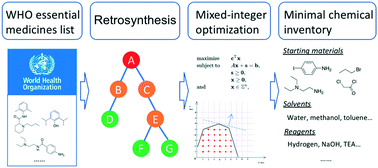当前位置:
X-MOL 学术
›
React. Chem. Eng.
›
论文详情
Our official English website, www.x-mol.net, welcomes your feedback! (Note: you will need to create a separate account there.)
Combining retrosynthesis and mixed-integer optimization for minimizing the chemical inventory needed to realize a WHO essential medicines list
Reaction Chemistry & Engineering ( IF 3.9 ) Pub Date : 2020/01/02 , DOI: 10.1039/c9re00348g Hanyu Gao 1, 2, 3, 4 , Connor W. Coley 1, 2, 3, 4 , Thomas J. Struble 1, 2, 3, 4 , Linyan Li 4, 5, 6 , Yujie Qian 3, 4, 7 , William H. Green 1, 2, 3, 4 , Klavs F. Jensen 1, 2, 3, 4
Reaction Chemistry & Engineering ( IF 3.9 ) Pub Date : 2020/01/02 , DOI: 10.1039/c9re00348g Hanyu Gao 1, 2, 3, 4 , Connor W. Coley 1, 2, 3, 4 , Thomas J. Struble 1, 2, 3, 4 , Linyan Li 4, 5, 6 , Yujie Qian 3, 4, 7 , William H. Green 1, 2, 3, 4 , Klavs F. Jensen 1, 2, 3, 4
Affiliation

|
The access to essential medicines remains a problem in many low-income countries for logistic and expiration limits, among other factors. Enabling flexible replenishment and easier supply chain management by on demand manufacturing from stored starting materials provides a solution to this challenge. Recent developments in computer-aided chemical synthesis planning have benefited from machine learning in different aspects. In this manuscript, we use those techniques to perform a combined analysis of a WHO essential medicines list to identify synthetic routes that minimize chemical inventory that would be required to synthesize the all the active pharmaceutical ingredients. We use a synthesis planning tool to perform retrosynthetic analyses for 99 targets and solve a mixed-integer programming problem to select a combination of pathways that uses the minimal number of chemicals. This work demonstrates the technical feasibility of reducing storage of active pharmaceutical ingredients to a minimal inventory of starting materials.
中文翻译:

将逆合成与混合整数优化相结合,以最大限度地减少实现WHO基本药物清单所需的化学药品清单
除其他因素外,在许多低收入国家,由于后勤和过期限制,基本药物的获取仍然是一个问题。通过使用存储的原材料按需制造来实现灵活的补货和更轻松的供应链管理,可以解决这一挑战。计算机辅助化学合成计划的最新发展已从不同方面的机器学习中受益。在本手稿中,我们使用这些技术对WHO的基本药物清单进行综合分析,以识别出合成途径,这些途径可最大程度地减少合成所有活性药物成分所需的化学药品库存。我们使用合成计划工具对99个目标进行逆合成分析,并解决混合整数编程问题,以选择使用最少化学物质的途径组合。这项工作证明了将活性药物成分的储存减少到最小的原料库存的技术可行性。
更新日期:2020-02-13
中文翻译:

将逆合成与混合整数优化相结合,以最大限度地减少实现WHO基本药物清单所需的化学药品清单
除其他因素外,在许多低收入国家,由于后勤和过期限制,基本药物的获取仍然是一个问题。通过使用存储的原材料按需制造来实现灵活的补货和更轻松的供应链管理,可以解决这一挑战。计算机辅助化学合成计划的最新发展已从不同方面的机器学习中受益。在本手稿中,我们使用这些技术对WHO的基本药物清单进行综合分析,以识别出合成途径,这些途径可最大程度地减少合成所有活性药物成分所需的化学药品库存。我们使用合成计划工具对99个目标进行逆合成分析,并解决混合整数编程问题,以选择使用最少化学物质的途径组合。这项工作证明了将活性药物成分的储存减少到最小的原料库存的技术可行性。



























 京公网安备 11010802027423号
京公网安备 11010802027423号